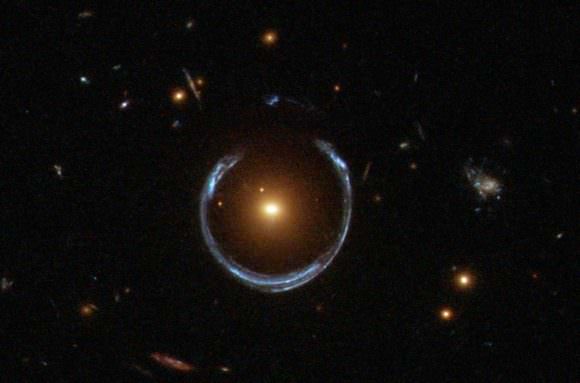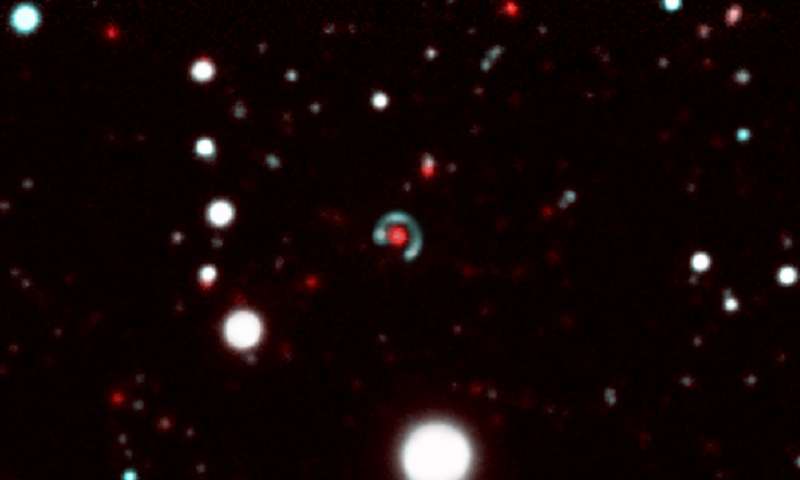A rare object called an Einstein Ring has been discovered by a team in the Stellar Populations group at the Instituto de Astrofísica de Canarias (IAC) in Spain. An Einstein Ring is a specific type of gravitational lensing.
Einstein’s Theory of General Relativity predicted the phenomena of gravitational lensing. Gravitational lensing tells us that instead of travelling in a straight line, light from a source can be bent by a massive object, like a black hole or a galaxy, which itself bends space time.
Einstein’s General Relativity was published in 1915, but a few years before that, in 1912, Einstein predicted the bending of light. Russian physicist Orest Chwolson was the first to mention the ring effect in scientific literature in 1924, which is why the rings are also called Einstein-Chwolson rings.
Gravitational lensing is fairly well-known, and many gravitational lenses have been observed. Einstein rings are rarer, because the observer, source, and lens all have to be aligned. Einstein himself thought that one would never be observed at all. “Of course, there is no hope of observing this phenomenon directly,” Einstein wrote in 1936.
The team behind the recent discovery was led by PhD student Margherita Bettinelli at the University of La Laguna, and Antonio Aparicio and Sebastian Hidalgo of the Stellar Populations group at the Instituto de Astrofísica de Canarias (IAC) in Spain. Because of the rarity of these objects, and the strong scientific interest in them, this one was given a name: The Canarias Einstein Ring.
There are three components to an Einstein Ring. The first is the observer, which in this case means telescopes here on Earth. The second is the lens galaxy, a massive galaxy with enormous gravity. This gravity warps space-time so that not only are objects drawn to it, but light itself is forced to travel along a curved path. The lens lies between Earth and the third component, the source galaxy. The light from the source galaxy is bent into a ring form by the power of the lens galaxy.
When all three components are aligned precisely, which is very rare, the light from the source galaxy is formed into a circle with the lens galaxy right in the centre. The circle won’t be perfect; it will have irregularities that reflect irregularities in the gravitational force of the lens galaxy.

The objects are more than just pretty artifacts of nature. They can tell scientists things about the nature of the lens galaxy. Antonio Aparicio, one of the IAC astrophysicists involved in the research said, “Studying these phenomena gives us especially relevant information about the composition of the source galaxy, and also about the structure of the gravitational field and of the dark matter in the lens galaxy.”
Looking at these objects is like looking back in time, too. The source galaxy is 10 billion light years from Earth. Expansion of the Universe means that the light has taken 8.5 billion light years to reach us. That’s why the ring is blue; that long ago, the source galaxy was young, full of hot blue stars.
The lens itself is much closer to us, but still very distant. It’s 6 billion light years away. Star formation in that galaxy likely came to a halt, and its stellar population is now old.
The discovery of the Canarias Einstein Ring was a happy accident. Bettinelli was pouring over data from what’s known as the Dark Energy Camera (DECam) of the 4m Blanco Telescope at the Cerro Tololo Observatory, in Chile. She was studying the stellar population of the Sculptor dwarf galaxy for her PhD when the Einstein Ring caught her attention. Other members of the Stellar Population Group then used OSIRIS spectrograph on the Gran Telescopio CANARIAS (GTC) to observe and analyze it further.


I’m curious as to how long Einstein rings can last. They must be a transient phenomenon because the camera, lens and object are all moving independently and cannot remain in alignment forever; especially considering the astronomical distances involved. This also means new alignments will continuously occur as old ones fade away.
Harmon – as you say this is a short-lived phenomena but only in interstellar terms. The change in the angles of these things at mega light year distances is so slight that you would be looking at millennium time periods for a change.
I don’t really grasp the ‘lens galaxy’ aspect. what makes up this galaxy?
It’s not what it’s made of but how much mass it has that bends the light!
Hang on, 8.5 billion light years out and it’s blue? How much redshift has it undergone?
Or the miniscule photon mass (not zero as “defined” for simplification of atomic mass calculations) is just pulled by the gravity of the large masses — no “spacetime” warping required.